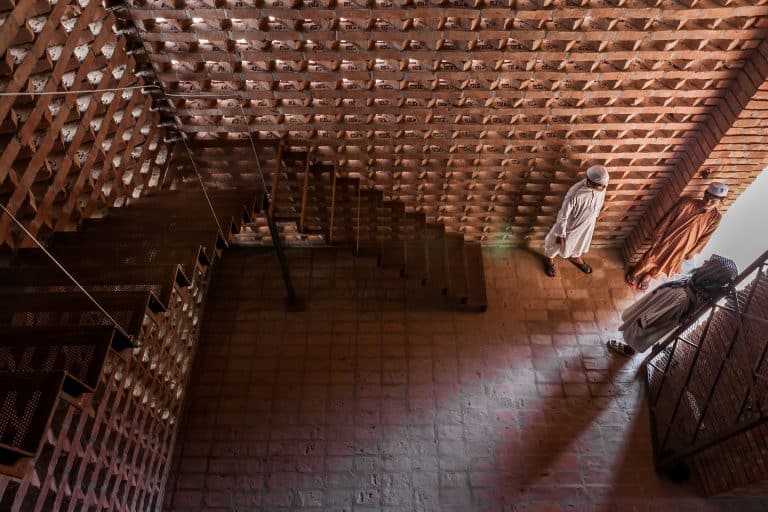
Image by Hassan Saifuddin Chandan/Marina Tabassum Architects, © All Rights Reserved.
Everyone Deserves Good Design
One evening, as my family was having dinner, my then two-and-a-half-year-old, Maya, froze mid-bite and said with a frightened look in her eyes, “What’s going to happen?!”
At first, my wife and I were flummoxed. What was she talking about? We were just sitting there eating our dinner and otherwise enjoying a rare moment of silence.
Except it wasn’t silent. We’d been playing the music of Prince constantly since his death. Maya had just heard the dramatic intro to the song “Let’s Go Crazy,” and it had struck an ominous chord deep inside her.
I’ve been fascinated to witness how music, not monsters, has the capacity to scare our toddler. It organizes her experience on some deep, subconscious level — triggering her fight-or-flight response or filling her with a joyful impulse to dance.
I believe that this is how design functions in our lives — like the soundtrack that we’re not even fully aware is playing. It sends us subconscious messages about how to feel and what to expect. Just as my daughter, who has an entirely untrained ear, can hear a few chords and sense that something is off, I think each of us has an organic way of processing the signals that design sends us.
It’s what environmental psychologists have described as “place identity” — essentially that the foremost building blocks of our sense of self are actually the spaces in which we live, work, and play. It’s what I have come to simply call dignity.
Dignity is to design what justice is to law and health is to medicine. In the simplest of terms, for me, dignity is about knowing your intrinsic worth and seeing that worth reflected in the places you inhabit. It’s about being primed for your full potential.
Dignity is a kid in rural China learning in a colorful classroom that makes him feel valued and piques his curiosity. Dignity is a public space in Atlanta where young and old, rich and poor alike mingle, celebrate, and play. Dignity is a cancer patient in a light-filled hospital ward in rural Rwanda with lots of natural airflow to support her healing.
Almost nothing influences the quality of our lives more than the design of our homes, our schools, our workplaces, and our public spaces. Yet design is taken for granted. People don’t realize they deserve better or that better is even possible. Like my daughter, they are affected by design but don’t know how to name what is happening.
For too long, design has been seen as a luxury, the province of the rich, not the poor, who often need it most. That can no longer be acceptable to those of us in the design field, nor to those affected by the field’s too often anemic moral imagination, which is to say, absolutely everybody.
My wife, On Being columnist Courtney Martin, claims to have known nothing about design before we met a handful of years ago. Like many people, she thought design was little more than a luxury for the rich. She assumed it had almost nothing to do with her and certainly had very little to do with the activists and social entrepreneurs she was writing about on a regular basis.
But as I introduced her to comfortable waiting rooms in health clinics, and community centers that looked like children’s museums — tactile, playful, and bright — she realized that everyone deserves good design. She came to understand that design is, in fact, a foundational building block of the kind of social justice she was so hell-bent on writing about and fighting for.
The words of one of her literary heroes, Virginia Woolf, took on new meaning. It wasn’t just “a room of one’s own” that women and other historically disenfranchised people needed; it was “a well-designed room of one’s own.” Beauty, she realized, is not a luxury.
As with Courtney, I want to awaken in people from all walks of life the realization that they too deserve good design. I believe this can be a clarion call for all of us — designers and nondesigners alike — to demand more, not just from one another but for and with one another.
Over the past two years, while writing Design for Good, I interviewed upwards of 100 people from all walks of life about their experience of design. I wanted to test my hunch that dignity and design are uniquely related.
I listened to Gregory Philen, a resident of a cottage community designed specifically for the 50 most chronically homeless people in Dallas. Philen had been living on the street for over 30 years, drifting from town to town. A broad coalition of social service agencies, funders, and designers created this place; each 400 square foot cottage is beautifully designed as a permanent home. Philen now has a key, to a door, to his own house. He talked about the sense of security that it brings — something he had lived without for decades. When he moved in with little more than the clothes on his back, there was everything from a toaster, a Crockpot, and stove, to a toothbrush and toothpaste awaiting him. He describes it simply as “heaven.”
On the other side of the world, I listened to Marina Tabassum, architect of the Bait Ur Rouf Mosque in Bangladesh. The mosque is both a sanctuary for religious practice and a vital gathering place for an under-resourced community on the outskirts of Dhaka. Designed by Tabassum in honor of her late mother, the mosque is known as the “House of the Compassionate.” Forgoing many of the symbols traditionally associated with mosques, the building is elegant in its design and construction and is very clearly a labor of love. Tabassum explains, “Buildings, for me, are living beings. They breathe. They have a soul of their own.”
Back here in the U.S., I listened to Monika Fischer-Massie, the director of a free health clinic in Arkansas that serves thousands of uninsured people. Fischer-Massie told me that the doctors who volunteer at her clinic frequently tell her they’ve never worked in such a beautiful, light-filled place. Fischer-Massie believes people experiencing poverty deserve quality health care, and they deserve to receive it in a dignified setting.
Well-designed spaces are not just a matter of taste or a question of aesthetics; they literally shape our ideas about who we are and what we deserve in the world.
That is the essence of dignity — and both the opportunity and the responsibility of design.
For good.
And for all.
John Cary is the author of the book, Design for Good: A New Era of Architecture for Everyone. You can watch his TED talk on this subject here:

